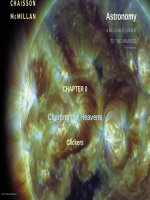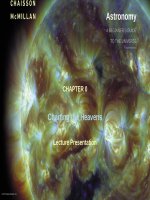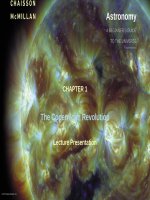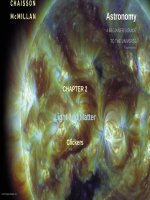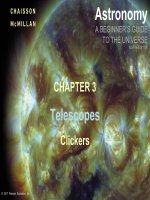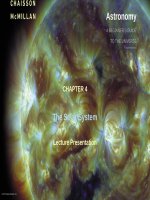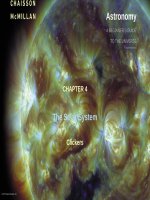Astronomy a beginners guide to the universe 8th CHaisson mcmillan chapter 06
Bạn đang xem bản rút gọn của tài liệu. Xem và tải ngay bản đầy đủ của tài liệu tại đây (6.36 MB, 39 trang )
Astronomy
A BEGINNER’S GUIDE
TO THE UNIVERSE
EIGHTH EDITION
CHAPTER 6
The Terrestrial Planets
Lecture Presentation
© 2017 Pearson Education, Inc.
Chapter 6 The Terrestrial Planets
© 2017 Pearson Education, Inc.
Units of Chapter 6
•
•
•
•
•
•
•
•
•
Orbital and Physical Properties
Rotation Rates
Atmospheres
The Surface of Mercury
The Surface of Venus
The Surface of Mars
Internal Structure and Geological History
Atmospheric Evolution on Earth, Venus, and Mars
Summary of Chapter 6
© 2017 Pearson Education, Inc.
6.1 Orbital and Physical Properties
•
The orbits of Venus and Mercury show that these planets never appear far from the Sun.
© 2017 Pearson Education, Inc.
6.1 Orbital and Physical Properties
•
The terrestrial planets have similar densities and roughly similar sizes, but their rotation
periods, surface temperatures, and atmospheric pressures vary widely.
© 2017 Pearson Education, Inc.
6.2 Rotation Rates
•
Mercury can be difficult to image from Earth, rotation rates can be measured by radar.
© 2017 Pearson Education, Inc.
6.2 Rotation Rates
•
Mercury was long thought to be tidally locked to the Sun; measurements in 1965 showed
this to be false.
•
Rather, Mercury’s day and year are in a 3:2 resonance; Mercury rotates three times while
going around the Sun twice.
© 2017 Pearson Education, Inc.
6.2 Rotation Rates
Venus
© 2017 Pearson Education, Inc.
Mars
6.2 Rotation Rates
•
All the planets rotate in a prograde direction, except Venus, which is retrograde.
© 2017 Pearson Education, Inc.
6.3 Atmospheres
•
Mercury has no detectable atmosphere; it is too hot, too
small, and too close to the Sun.
•
Venus has an extremely dense
atmosphere. The outer clouds are
similar in temperature to Earth,
and it was once thought that Venus
was a “jungle” planet. We now know that its surface is hotter
than Mercury’s; hot enough to melt lead.
•
The atmosphere of Mars is similar to Earth in composition,
but very thin.
© 2017 Pearson Education, Inc.
6.4 The Surface of Mercury
•
Mercury cannot be imaged well from Earth.
The best pictures are from Messenger.
•
Cratering on Mercury is
similar to that on
the Moon.
© 2017 Pearson Education, Inc.
6.4 The Surface of Mercury
•
A distinctive feature is the scarps (cliffs),
several hundred kilometers long and up
to 3 km high, is thought to be formed as
the planet cooled and shrank.
© 2017 Pearson Education, Inc.
6.4 The Surface of Mercury
•
Caloris Basin, a very large impact feature, ringed by concentric mountain ranges
© 2017 Pearson Education, Inc.
6.5 The Surface of Venus
•
This map of the surface features of Venus
is on the same scale as the Earth map
below it.
© 2017 Pearson Education, Inc.
6.5 The Surface of Venus
•
Venus as a globe, imaged by Magellan
© 2017 Pearson Education, Inc.
6.5 The Surface of Venus
Top: Lava domes on Venus (L), and a computer
reconstruction (R)
Bottom: The volcano Gula Mons
© 2017 Pearson Education, Inc.
6.5 The Surface of Venus
•
Venus corona, with lava domes
© 2017 Pearson Education, Inc.
6.5 The Surface of Venus
•
A photograph of the surface of Venus from the Venera lander
© 2017 Pearson Education, Inc.
6.5 The Surface of Venus
Impact craters.
Left: multiple-impact crater Above: Mead,
Venus’s largest impact crater
© 2017 Pearson Education, Inc.
6.6 The Surface of Mars
•
Major feature: The Tharsis bulge is the
size of North America and rises 10 km
above its surroundings.
•
With minimal cratering, it is the youngest
surface on Mars.
© 2017 Pearson Education, Inc.
6.6 The Surface of Mars
•
•
Northern hemisphere (top) is rolling volcanic terrain.
Southern hemisphere (bottom) is heavily cratered highlands; average altitude is
5 km above the northern.
•
Assumption is that the
northern surface is younger
than the southern.
•
This means that the northern
hemisphere must have been
lowered in elevation and then
flooded with lava.
© 2017 Pearson Education, Inc.
6.6 The Surface of Mars
•
This map shows the main surface features of Mars. There is no evidence of plate
tectonics.
© 2017 Pearson Education, Inc.
6.6 The Surface of Mars
•
Mars has the largest volcano in the solar system, Olympus Mons:
–
–
–
•
700 km diameter at base
25 km high
Caldera 80 km in diameter
Four other Martian volcanoes are only slightly smaller.
© 2017 Pearson Education, Inc.
6.6 The Surface of Mars
•
•
Was there running water on Mars?
Runoff channels resemble those on Earth.
Left: Mars
Right: Earth
© 2017 Pearson Education, Inc.
6.6 The Surface of Mars
•
There is no evidence of a connected river system. The features are probably due to flash
floods.
© 2017 Pearson Education, Inc.
